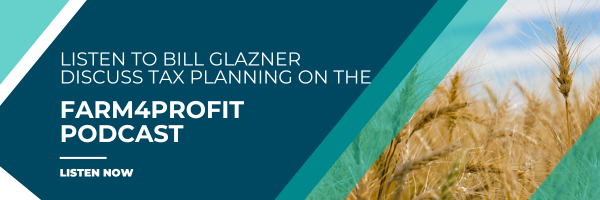Deferral of Crop Insurance Proceeds
Weather conditions across portions of the Midwest left many crops in poor condition. This means many farmers are looking at much greater crop insurance payouts than in previous years. This also raises the question in many minds as to how and when the insurance proceeds are taxed. Generally, all crop insurance proceeds are to be included in taxable income in the year received. However, one exception provides that the income recognized on certain crop insurance proceeds can be deferred until the following year if certain conditions are met.
Qualifications
Section 451 of the tax code provides farmers with the option to defer the income on crop insurance proceeds provided the following conditions apply:
- The farmer reports their income on a cash basis (not accrual).
- The crop insurance proceeds are received in the same tax year the crop damage occurred.
- During a typical year, the farmer’s standard business practice would be to sell more than 50 percent of the crops harvested the following year after the harvest.
Cash Basis
The option to defer crop insurance income into the following year only applies to farmers using the cash basis of accounting. While most farmers default to the cash basis of accounting, those that elect to report their income on an accrual basis will not have the option to defer the recognition of income.
Year of Receipt
To be deferred from income, the crop insurance payout must have occurred in the same year that damage to the crops occurred. For example, suppose the insurance proceeds are not received until after the end of the year (December 31st for calendar year taxpayers). In this case, the IRS deems the income has already been deferred and thus is not eligible for further deferral. Information regarding the year of damage for crop insurance proceeds can often be found on the back of or included with the Form 1099-MISC received from the insurance company.
Normal Business Practice of Deferral
To qualify for deferral, the IRS requires the deferral of insurance proceeds reflects the farmer’s “normal business practice.” If the farmer typically sells crops as they are harvested or shortly after, the option to defer the insurance income will likely not be available. However, for those farmers whose routine operations consist of storing grain and selling more than 50 percent of it in the year after harvest, the election to defer may be an option.
When multiple crops are involved, the determination becomes more complicated. In these cases, the greater than 50 percent sold in the following year test is applied to each crop for which the farmer received insurance proceeds.
“All or Nothing” Caveat
One provision of the Section 451 exclusion can be a stumbling point for some taxpayers. This is because the election to defer the income from crop insurance proceeds is an “all or nothing” election. If the election is made, all income from the payout must be deferred and recognized in the following year. There is no option to choose how much income you want to defer. In instances where insurance proceeds are received on multiple crops, the all-or-nothing requirement still holds. If the farmer is eligible to defer the insurance income, the election must be made for all crops damaged or none of the crops. A taxpayer cannot elect to defer the insurance proceeds on one crop but not another in the same year.
There is, however, one exception to the all-or-nothing requirement. This exception provides that if separate businesses are maintained for each crop, each company’s election may be made individually. However, this would require separate entities and books for each crop and is rarely found in practice.
Damages vs. Revenue Loss
One final limitation on the ability to defer insurance proceeds income concerns the nature of the insurance proceeds received. Generally, insurance payouts can be categorized as either payout for crop damages or revenue loss. Payouts for damages such as drought, flood and fire are eligible for deferral, unlike payouts aimed at revenue protection, commonly referred to as price loss, which do not qualify for deferral.
Questions?
These deferral options can provide much-needed tax relief to farmers and ranchers who are already facing tough times. However, the process can be complicated as there are several regulations. In addition, deferral may only sometimes be advantageous based on future year’s income, tax law changes, and economic conditions. Please contact your Adams Brown advisor if you have questions regarding these deferral options.


